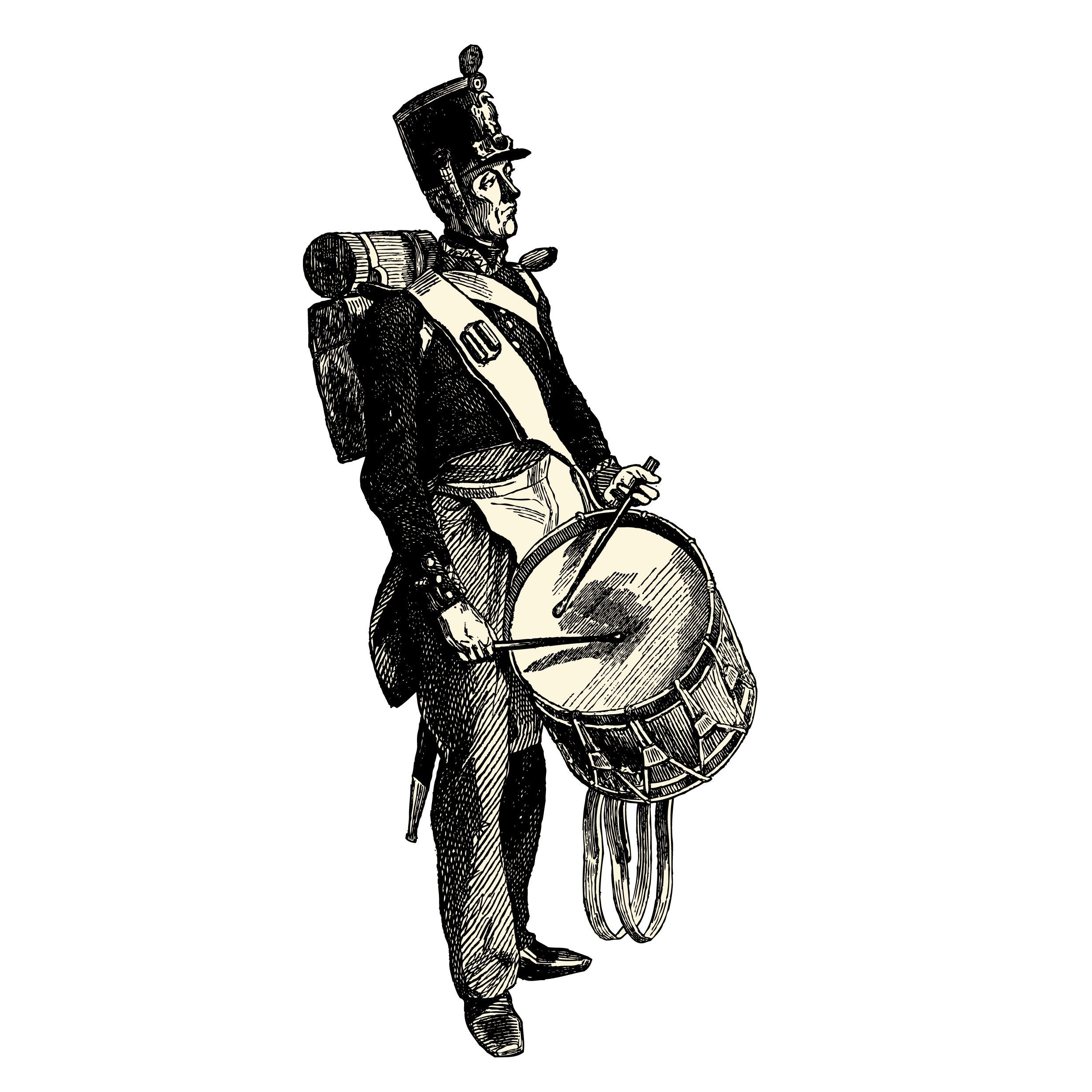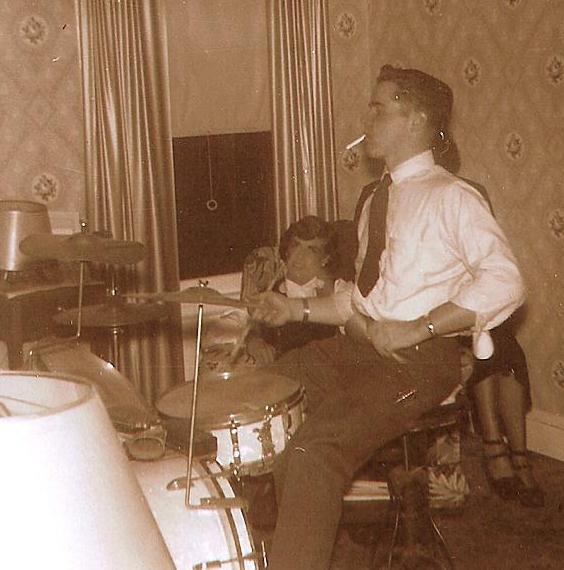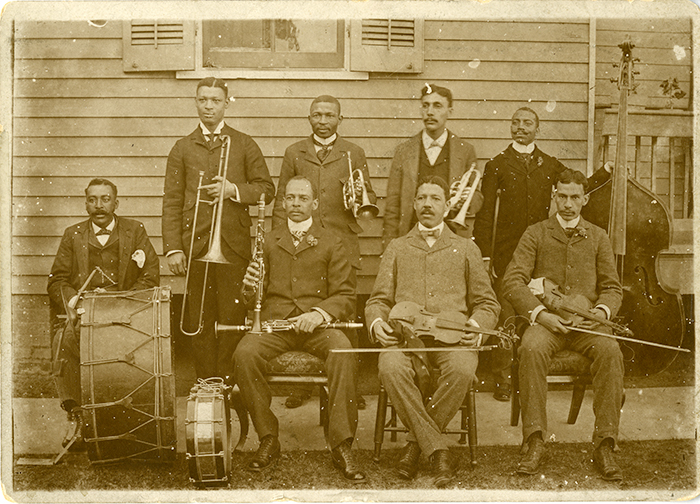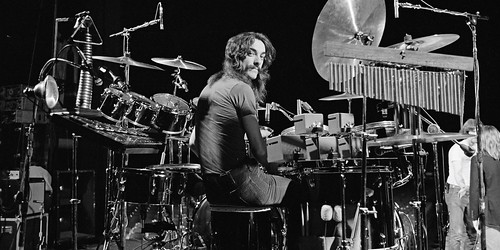
Q: How many musicians does it take to screw in a light bulb?
A: Five. One drummer to screw in the light bulb and the rest of the band to talk about how much better Neil Peart could have done it.
Guitar players and singers may get most of the attention, but without the drummer modern music wouldn’t exist. Without the drum kit, the modern drummer wouldn’t exist, so logically we can say that it’s the modern drum kit that made it all possible. With that in mind, here’s a bit of history about one of the most important developments in music history.
But first…the grip. Did you ever notice some drummers place the stick of their non-dominant hand between their thumb and forefinger, while other drummers hold both sticks the same way using their thumbs and fingertips? The latter is called the matched grip and the former is known as the traditional grip. The origins of the traditional (or trad) grip go all the way back to 18th century military drummers.
A: Five. One drummer to screw in the light bulb and the rest of the band to talk about how much better Neil Peart could have done it.
Guitar players and singers may get most of the attention, but without the drummer modern music wouldn’t exist. Without the drum kit, the modern drummer wouldn’t exist, so logically we can say that it’s the modern drum kit that made it all possible. With that in mind, here’s a bit of history about one of the most important developments in music history.
But first…the grip. Did you ever notice some drummers place the stick of their non-dominant hand between their thumb and forefinger, while other drummers hold both sticks the same way using their thumbs and fingertips? The latter is called the matched grip and the former is known as the traditional grip. The origins of the traditional (or trad) grip go all the way back to 18th century military drummers.
Drummers were an integral part of battlefield communication, especially in Europe, from about the 17th Century. Military drummers were generally pre-teenaged boys and men who were too old to fight; their drums – generally about the same size as a modern floor tom – were strapped to their hips on their non-dominant side. This meant holding the non-dominant stick between the fingertips wouldn’t work because of the arm position, so the traditional grip developed out of necessity. As ex-military drummers after the American Civil War began to play in early jazz ensembles at the end of the 19th Century, they used the only grip they knew. This carried forward into the Jazz Age and is the main reason why the traditional grip is so closely associated with modern jazz drummers – the tradition was simply introduced to each new generation of drummer. Marching band drummers to this day still use the traditional grip, so if you see a rock or jazz drummer using the trad grip, chances are they have a marching band background!

Although the drum kit as we know it today came into prominence during the early years of jazz in New Orleans, it actually has its roots in stage and theatrical productions dating back as early as the late 1840s. As the popularity of small theaters and traveling shows grew, the ever present need to economize both space and money forced musical directors to downsize. To properly perform the percussive parts of a musical score, it might have required several percussionists who spent the majority of the performance waiting to clap a cymbal or strike a drum – certainly not cost effective. That’s when the “drum contraption” kit began to appear on the scene. Basically a table with a variety of percussion instruments, the drum contraption kit morphed into the “trap kit” – a precursor of the modern drum kit.
Early jazz musicians, particularly in New Orleans – the Birthplace of Jazz – were generally former military musicians, and martial music was a cornerstone of the style. We’re all familiar with the New Orleans street bands that are still a fixture of the city’s music scene today. When playing for free during Mardi Gras or a funeral, having several percussionists to handle the big bass drum, snares and cymbals wasn’t a problem, but as the music began to be played in night clubs economics once again played a role in how many musicians a band could bring to a show.
Picture at right from author's personal collection, circa 1952.
Early jazz musicians, particularly in New Orleans – the Birthplace of Jazz – were generally former military musicians, and martial music was a cornerstone of the style. We’re all familiar with the New Orleans street bands that are still a fixture of the city’s music scene today. When playing for free during Mardi Gras or a funeral, having several percussionists to handle the big bass drum, snares and cymbals wasn’t a problem, but as the music began to be played in night clubs economics once again played a role in how many musicians a band could bring to a show.
Picture at right from author's personal collection, circa 1952.


The modern drum kit could really only have developed in a port city. In the 19th and early 20th Centuries the world was nowhere near as connected as it is today, and the only places that had any type of contact with other countries and cultures were ports. The modern drum kit contains tom-tom drums from China and elsewhere in Asia, cymbals from the Middle East and Asia, bass and snare drums from Europe and assorted percussive instruments from Africa and the Caribbean. It’s easy to see that New Orleans and the jazz music that grew up there was the most likely birthplace of such a conglomeration of noise makers like the drum kit. Think about this, renowned cymbal maker, the Avedis Zildjian company just celebrated its 400th Anniversary. The company spent the first 304 years of its existence in Turkey and the last 96 years in Massachusetts. Once jazz music and the drum kit hit the scene, manufacturing cymbals became a much more profitable and far-reaching business and the obvious place to be was where the music was.
The first recognizable drum kit as we know it came about after New Orleans drummer Dee Dee Chandler (pictured at left) affixed a crude pedal to his bass drum freeing up both hands to develop polyrhythms on the snare or toms revolutionizing percussion, and music in general. His device consisted of a rope and pulley attached to a beater – he would ‘kick’ the base of the pulley device which would then strike the skin of the bass drum. Although the device was terribly slow and hard to control in a rhythmic way, in 1896 he was pictured as the first modern “kit drummer.”
The first recognizable drum kit as we know it came about after New Orleans drummer Dee Dee Chandler (pictured at left) affixed a crude pedal to his bass drum freeing up both hands to develop polyrhythms on the snare or toms revolutionizing percussion, and music in general. His device consisted of a rope and pulley attached to a beater – he would ‘kick’ the base of the pulley device which would then strike the skin of the bass drum. Although the device was terribly slow and hard to control in a rhythmic way, in 1896 he was pictured as the first modern “kit drummer.”
Brothers William and Theobald Ludwig applied for the first patent of their version of this bass drum pedal device in 1909. Their version of the pedal sat on the floor and used a spring fulcrum assembly which allowed the drummer to develop more sophisticated rhythms using their foot. In 1936, the Ludwig Company described their groundbreaking drum pedal as “twenty-five years of pedal progress” and “the foundation of the Ludwig company.” The Ludwig “Speed King” pedal was introduced in 1934 and was the premiere kick drum pedal until well into the Classic Rock era.
Lastly, the development of the drum kit owes its existence to a large extent to the music itself. The groove and “swing” that defined jazz and then blues music was difficult – if not impossible – to develop with several drummers playing at the same time. The beat had to remain somewhat rigid in order to accommodate each percussionist’s rhythmic interpretation. Today, multiple percussionists can develop all sorts of wonderful grooves and polyrhythms simply because they have a century and a quarter of example to follow, but it wasn’t until singular drummers playing a collection of percussive instruments at the same time that the swing that defines music to found its groove.

So hats off to the innovators who had the vision to build the most foundational of all the modern instruments – the drum kit, and to those drummers who took this innovation and developed the sound that keeps us swinging to this day.

By Jack Sharkey for KEF. Jack is Senior Technical Engineer at KEF America, and a lifelong drummer (so the drummer jokes are okay.)



